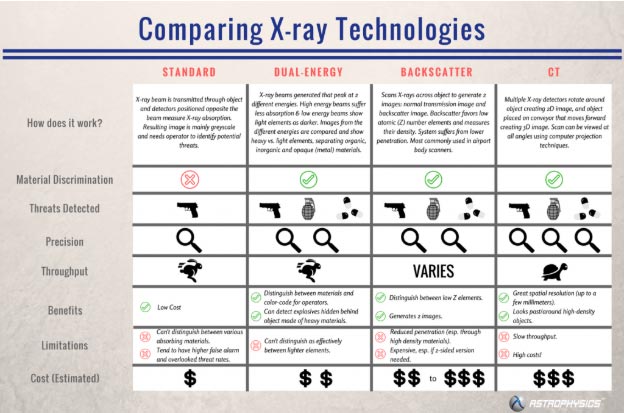Few people know about the four x-ray technologies: Standard, Dual-energy, Backscatter and Computerized Tomography (CT). These aren’t exactly cocktail party conversation material. But if you work in law enforcement, patrol borders or work for the TSA you’ve done your homework and know these x-ray technologies. These x-rays help keep you safe and protect the people and assets you promise to serve.
Unless you’re one of those chosen few, the x-ray technologies are likely a mystery to you. Fear not – we’ve put together a handy x-ray overview to get you up to speed. The infographic below summarizes the key differences between the x-ray technologies. And this post explains each in detail – their advantages, disadvantages, costs and uses.
So press on, future x-ray aficionado. After reading this overview we’re sure you’ll be the life of every party (or at least the x-ray expert).

STANDARD X-RAY TECHNOLOGIES
Think about black and white x-rays you see at the doctor’s office. Those are a great reference for the first of these x-ray technologies.
Standard x-ray beams travel through objects and hit detectors placed opposite the generator. The detectors measure x-ray absorption and the machine produces a (usually) greyscale image. Standard x-ray machines can’t identify different absorbing materials. They only show how much x-ray absorption occurred between the generator and detectors.
Operators study the images to look for hidden threats. Experienced operators use pattern recognition to find unusual or suspicious objects, like weapons. But these machines produce high false alarm rates because operators can only see shapes. Without material discrimination tools they cannot get a complete picture of the scanned objects. They struggle to find drugs and explosives which lack easily identifiable shapes like guns and knives.
Standard X-rays do offer high throughput (speed to scan) with a low price tag. They work best when installed in high-traffic locations that don’t need precise security inspections.
DUAL-ENERGY X-RAY TECHNOLOGIES
Frequent fliers are quite familiar with TSA’s x-rays scanners and go through these machines every time they travel. These Dual-energy systems scan carry-on luggage to ensure passengers safely arrive at their destinations.
Dual-energy x-rays are exactly what their name says. They use two x-ray beams peaking at different energies (high and low) and pass them through an object. Few of the high energy beams get absorbed so high and low energy absorption rates get compared to each other. The differences show light (carbon, oxygen, and nitrogen) and heavy elements in the image. Colors are also applied to show which items are organic, inorganic or metallic materials.
This material discrimination helps operators locate suspicious objects and identify potential threats. Skilled Dual-energy operators can find explosives (light elements) hidden behind heavier elements (metals). And the improved precision doesn’t reduce the scanner throughput when compared to Standard x-rays.
Dual-energy x-rays aren’t perfect security scanners. They can’t easily distinguish between various lighter elements. They are also more expensive than their Standard x-ray counterparts. Despite these limitations, Dual-energy x-rays are effective all-around scanners. And that explains why they are common sights at airport security checkpoints.
BACKSCATTER X-RAY TECHNOLOGIES
Sticking with our travel theme, Backscatter x-rays are often found in airport body scanners.
Backscatter x-rays use two different detectors to measure beam absorption and penetration. This produces 2 images the operator reviews to find suspicious objects. The first, a transmission image, shows traditional x-ray beam absorption. The second, a backscatter image, forms when the beam bounces back towards the detector. Transmission images show heavy elements and Backscatter images show light elements.
It would seem like combining transmission and Backscatter would create the perfect x-ray scanner. But that isn’t the case. Backscatter x-rays are great for penetrating organic materials. That’s why they’re used in airport body scanners. Yet they struggle to penetrate heavier (i.e. metal) materials.
This means Backscatter machines that aren’t scanning people need to be two-sided. These systems need two sets of equipment to ensure penetration through dense objects. This can make Backscatter units more expensive than Standard and Dual-energy x-rays. And it explains why Backscatter is less common outside of airport body scanners.
COMPUTERIZED TOMOGRAPHY (CT) TECHNOLOGIES
CTs are a lot like medical CAT scans – powerful and precise, but slower and more expensive than other x-rays.
CTs use many detectors installed on a rotating system that surrounds the scanned object. X-ray beams penetrate the target and the system’s rotation helps create 2D slices of the object. A conveyor then moves the object through the machine and captures multiple 2D slices. These slices are then combined in a computer to create a complete 3D image of the object.
The 3D image offers the operator fantastic spatial resolution and inspection tools. CTs can look past or around elements obstructing the operator’s view. This makes threats harder to hide since operators can just rotate the image and see around obstructions blocking their view.
This powerful imaging technology comes at a price, though. 3D CT systems cost more than most other x-ray scanners. It also takes extra time to compute and generate 3D images. This reduces throughput, making CT less-than-ideal for locations that need quick inspections.
There you have it – a quick overview of the four most common x-ray technologies. There are variations of these systems, but most scanners fall into one of the four x-ray types. Keep this reference handy the next time you’re evaluating x-ray systems. And then contact our helpful Astrophysics, Inc. sales reps who will help you find the perfect scanner for your security needs.
Astrophysics, Inc. makes hidden threats visible. We manufacture leading x-ray security scanners and offer cutting-edge imaging for any application and budget. Operators in 138 countries use our advanced system features, including 6-Color Imaging and Picture Perfect functionality, to detect threats and contraband hidden within everything from suitcases to cargo containers. Astrophysics, Inc. units adhere to rigorous industry specifications, and we offer qualified scanners for any security mission. Follow us on Twitter and LinkedIn for the latest news and x-ray product updates.
